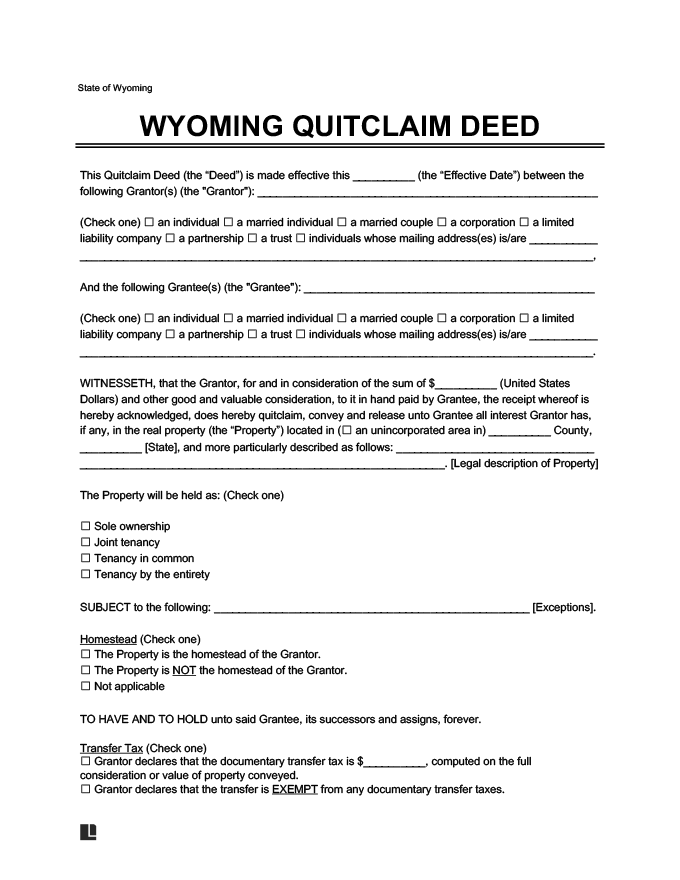A quitclaim deed in Wyoming lets a property owner transfer their property to another individual without any title or ownership warranties. It’s useful when the property owner needs to make a gift, remove their spouse from the title, clear a title issue, or transfer property to a close friend or family member.
Explore the requirements to learn how to execute this document while complying with state regulations.
Legal Framework
Wyo. Stat. § 34-2-104 provides a standard quitclaim form. Wyo. Stat. § 34-2-105 states that a quitclaim deed transfers the property as-is with no title guarantees. It won’t transfer any title that the grantor acquires in the future unless the document explicitly provides these instructions.
Legal Description
Wyoming’s statutory form requires a legal description of the property. While the state doesn’t specify what entails a legal description, it usually includes the following information:
- Lot and block
- Metes and bounds
- Landmarks or monuments
- Governmental surveys
Signing
A valid signature from the grantor (the party currently owning the property) affirms the transfer. A notary must confirm that signature and stamp and sign the document, as per Wyo. Stat. § 34-1-113.
Terminology
Wyo. Stat. § 34-2-106 doesn’t require using the word “release” to convey property. The document should use the word “quitclaim” for clarity.
Any quitclaim deeds that grantors have previously executed in the state are valid and have the same legal effect whether they include the term “release.”
Additional Documents
To file a quitclaim deed, Wyo. Stat. § 34-1-142 requires a Statement of Consideration Form, which lays out the property’s purchase price and any other terms of payment. Subsection (c) outlines some instances in which the grantor doesn’t have to fill out a statement of consideration form, including the following:
- The confirmation, correction, or modification of a previously recorded instrument with no additional consideration.
- A transfer pursuant to reorganizations, consolidations, or mergers of business entities.
- A transfer that involves a gift of more than half of the true value.
- A transfer between a parent and child or husband and wife with only nominal consideration.
- A sale for delinquent taxes or assessments (or a transfer or sale relating to a foreclosure).
- A deed that transfers the property to the same party.
- A transfer by a subsidiary corporation to its parent corporation without actual consideration or in consideration of the surrender of a subsidiary stock.
- Any transfer that the Department of Revenue and State Board of Equalization exempts upon finding that the information isn’t relevant in determining sales-price ratios.
Filing
Wyo. Stat. § 34-1-118 requires quitclaim deeds to be filed with the county clerk’s office in the county where the property is located. Until the grantor completes the filing process, they maintain possession of the property and all associated responsibilities.
Validity Requirements
A quitclaim deed must follow Wyoming’s general rules for deeds, including formatting requirements. These requirements include the following (Wyo. Stat. § 34-1-119):
- A top margin of at least 3 inches on the deed’s first page.
- The new owner’s mailing address.
- Names and identification information for all involved parties.
- A legal description of the property (including the property’s address, boundaries, and other information in the title).
In addition, Wyoming notes that if the property is a homestead, the owner must waive the homestead rights to that piece of land (Wyo. Stat. § 34-2-121).
Content Requirements
A quitclaim deed must contain essential information that lays out the property transfer. This information includes:
- The name and address of the grantor.
- A notice that the grantor conveys and quitclaims all interests in the property.
- The grantee’s name.
- The legal description of the property.
It should not contain any notice about warranties or guarantees on the property.
Quitclaim Deeds vs. Other Property Transfer Methods
| Quitclaim Deed | Makes no guarantees about the title and right to transfer property. Doesn't promise that the grantor will defend against third-party claims. |
| General Warranty Deed | Promises that the owner holds a good title and has the right to transfer the property. Ensures that the property has no encumbrances and that the current owner will defend the property's title against third-party claims. |
| Special Warranty Deed | Protects against any encumbrances or claims that were brought upon actions of the current owner. Offers no protection for encumbrances by past owners. |
| Survivorship Deed | Conveys property to two (sometimes more) co-owners who both hold title with a right of survivorship. |
| Life Estate Deed | Creates two separate interests (for the life tenant and the beneficiary) in the same property for the life tenant's lifetime. The life tenant needs the beneficiary's permission to transfer property. |
| Transfer on Death Deed | Lets the original owner maintain the complete title until they die. At their death, the title goes to a beneficiary. |
